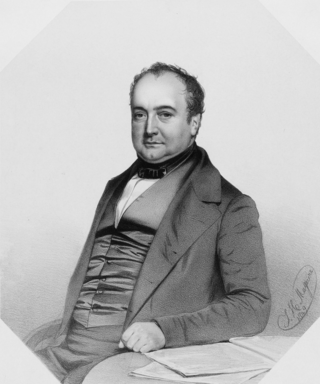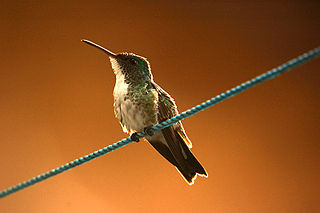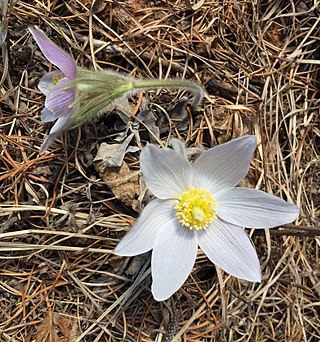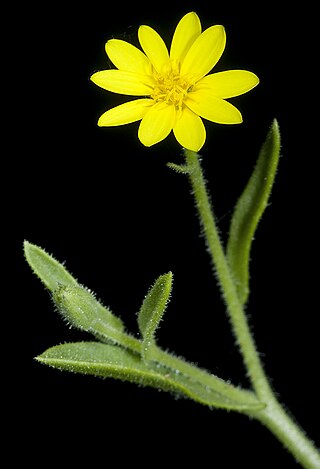
Charles Lucien Jules Laurent Bonaparte, 2nd Prince of Canino and Musignano was a French naturalist and ornithologist. Lucien and his wife had twelve children, including Cardinal Lucien Bonaparte.

Augustin Pyramusde Candolle was a Swiss botanist. René Louiche Desfontaines launched de Candolle's botanical career by recommending him at a herbarium. Within a couple of years de Candolle had established a new genus, and he went on to document hundreds of plant families and create a new natural plant classification system. Although de Candolle's main focus was botany, he also contributed to related fields such as phytogeography, agronomy, paleontology, medical botany, and economic botany.

Pallenis is a small genus of flowering plants in the tribe Inuleae within the family Asteraceae. The name is derived from palea (chaff), referring to the chaffy receptacle.

Alexander Georg von Bunge was a Russian botanist. He is best remembered for scientific expeditions into Asia and especially Siberia.

Theophrastoideae is a small subfamily of flowering plants in the family Primulaceae. It was formerly recognized as a separate family Theophrastaceae. As previously circumscribed, the family consisted of eight genera and 95 species of trees or shrubs, native to tropical regions of the Americas.

Banksia laevigata, commonly known as the tennis ball banksia, is a species of shrub that is endemic to Western Australia. It has serrated, broadly linear to narrow wedge-shaped leaves, yellow or yellowish green flowers, depending on subspecies, and linear to elliptic follicles with a slightly wrinkled surface.

Banksia splendida, commonly known as shaggy dryandra, is a species of shrub that is endemic to the southwest of Western Australia. It has sharply-pointed linear leaves that are woolly on the lower surface, cream-coloured and maroon or yellow flowers in heads of between 65 and 115, and later up to eight egg-shaped follicles in each head.

Symphyotrichum ericoides, known as white heath aster, frost aster, or heath aster, is a species of flowering plant in the family Asteraceae native to much of central and eastern North America. It has been introduced to parts of Europe and western Asia.

The plain-bellied emerald is a species of hummingbird in the "emeralds", tribe Trochilini of subfamily Trochilinae. It is found in Brazil, the Guianas, and Venezuela.

Symphyotrichum lateriflorum is a species of flowering plant in the aster family (Asteraceae). Commonly known as calico aster, starved aster, and white woodland aster, it is native to eastern and central North America. It is a perennial and herbaceous plant that may reach heights up to 120 centimeters and widths up to 30 centimeters.

Rosularia is a small genus of the family Crassulaceae. It includes about 28-35 species from Europe, the Himalayas, and northern Africa.
Anaxeton is a genus of flowering plants in the family Asteraceae.

Pulsatilla nuttalliana, known as American pasqueflower, prairie pasqueflower, prairie crocus, or simply pasqueflower, is a flowering plant native to much of North America, from the western side of Lake Michigan, to northern Canada in the Northwest Territories, south to New Mexico in the southwestern United States. Pasqueflower is the provincial flower of Manitoba and the state flower of South Dakota.

iNaturalist is an American 501(c)(3) nonprofit social network of naturalists, citizen scientists, and biologists built on the concept of mapping and sharing observations of biodiversity across the globe. iNaturalist may be accessed via its website or from its mobile applications. iNaturalist includes an automated species identification tool, and users further assist each other in identifying organisms from photographs. As of 17 June 2023, iNaturalist users had contributed approximately 161,278,660 observations of plants, animals, fungi, and other organisms worldwide, and around 350,000 users were active in the previous 30 days.
Lavushi Manda National Park is a national park in the Muchinga Province of Zambia with an area of 1,500 sq km. It is the 11th largest of the 20 National Parks in Zambia. The park was initially gazetted as a Game Reserve in 1941, and was declared a National Park in 1972. It is located in Muchinga Province, in a district of the same name (Lavushimanda), with the South Luangwa National Park in the neighbouring Mpika District. It is adjacent to Bangweulu Game Management Area to the northwest, Kafinda Game Management Area lies further west. The chiefdom of Chiundaponde is in the northwest, north lies Luchembe, northwest Chikwanda, east Mpumba, and south lies Muchinka chiefdom. It covers a small range of mountains and hills, and is principally covered in miombo woodlands, with a number of rivers and streams, and a few areas of grassland, both on drier land or in the form of seasonally wet dambos. There are few large mammals, due to poaching in the previous century, but fishing and hiking are possible. Certain antelope species retreat upland to the park from the Bangweulu swamps to the northwest during the rainy season.

Digitalis davisiana is a species of foxglove, a herbaceous plant in the genus Digitalis in the family Plantaginaceae, formerly in the Scrophulariaceae and briefly the Veronicaceae. It is native to Turkey.

Trochocarpa cunninghamii is a flowering plant species of the family Ericaceae. It is commonly referred to as straggling purpleberry due to its round flattened mauve drupe fruits. This woody shrub is usually found in the understorey of rainforests and subalpine forests in the Central Plateau and western Tasmania, and is endemic to Tasmania.

Osteospermum calendulaceum is a plant in the Asteraceae family. It was first described in 1782 by Carl Linnaeus the Younger. In 1832, Christian Friedrich Lessing assigned it to the genus Oligocarpus in his Synopsis Generum Compositarum.

Penstemon secundiflorus, commonly known as sidebells penstemon, or orchid beardtoungue is a species of Penstemon that grows in dry forests, high plains, and scrub lands from Wyoming to Mexico. It is a herbaceous perennial plant that typically grows to a height of 20 to 50 cm and has narrow, lance-shaped leaves that are grayish-green in color. The flowers of the sidebells penstemon are tubular in shape and are arranged in a one-sided spike, with the blooms all facing the same direction, and for this reason was named "secundiflorus", which means "one-sided flowers". The flowers are most often delicate shades of orchid or lavender. It is sometimes used in xeriscaping, rock gardens, and wildflower meadows, and is well-suited to dry, sunny locations with well-drained soil.























